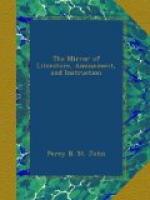Silk from Spiders.
At the last Anniversary of the Society of Arts, the Silver Isis Medal was presented to Mr. D.B. Rolt for obtaining Silk from the Garden Spider. We find the details in the volume of the Society’s Transactions lately published.
“The subject of Mr. Rolt’s experiments has been the garden spider, Aranea diadema, the webs of which, in autumn, are so conspicuous on the surface of shrubs and in other similar situations. On allowing one of these animals to crawl over his hand, he found that it drew a thread with it wherever it went: he likewise, without any difficulty, wound some of this thread over his hand, finding that the spider continued spinning while the thread was winding up.
“On this hint, he connected a small reel with the steam-engine of the factory in which he is occupied, and putting it in motion, at the rate of 150 feet per minute, found that the spider would thus continue to afford an unbroken thread during from three to five minutes. The specimen of this silk, which accompanies Mr. Rolt’s communication, was wound off from twenty-four spiders in about two hours. Mr. R. estimates its length at 18,000 feet; its colour is white, and its lustre is brilliant, and completely metallic, owing, probably, to its great opacity. No attempt has been made by him to combine two or more filaments into one by winding, nor, of course, to form it into thread by throwing.
“The thread of the garden spider is so much finer than that of the silk-worm, that the united strength of five of the former is, according to Mr. Rolt, equal only to one of the latter; and, assuming that the weight is in proportion to the strength, and that a spider will yield twice a-year a thread 750 feet long, while that produced by a single silk-worm is 1,900 feet, it follows that the produce of one silk-worm is equal to that of 6.3 spiders. Now, as on an average it takes about 3,500 silk-worms to produce a pound of silk, it would take about 22,000 spiders to produce an equal quantity. Besides, spiders are not so easily confined as silk-worms, and whenever two come in contact, a battle ensues, which ends in the destruction of the weaker one. Spiders kept for silk must, therefore, be each in separate dens or cells; and the apparatus contrived by Mr. Rolt for this purpose, although very ingenious and well adapted to carry on a course of experiments with a hundred or two, would manifestly be wholly inapplicable to any purpose of commercial utility. Mr Rolt has, however, made some interesting additions to the history of the garden spider, and has obtained the silk in its natural state, exhibiting all its peculiar lustre; his method, likewise, of winding the silk directly from the animal is, to say the least of it, effectual and ingenious.”
It should be added that “the Society are of opinion that it will never be possible to employ spiders’ silk, beautiful as it is, in any profitable manufacture; but have thought proper to confer a reward on this gentleman for his communication, as forming an interesting addition to the natural history of the spider.”




